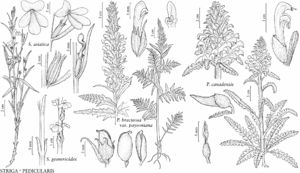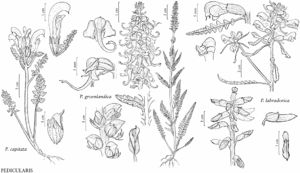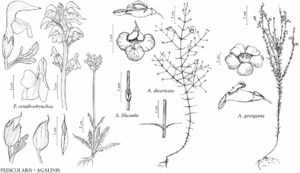Pedicularis
Sp. Pl. 2: 607. 1753.
Herbs, perennial [annual]; hemiparasitic, rhizomatous, caudex woody or fleshy, scaly. Stems erect, fleshy, glabrous, hispid, villous, or woolly. Leaves: basal rosette [absent], petiole present, blade not fleshy, not leathery, margins entire, serrate, or crenate; cauline alternate, rarely whorled [nearly opposite], sometimes absent, petiole present or absent, blade chartaceous, margins entire, serrate, or crenate. Inflorescences terminal or axillary, racemes; bracts present. Pedicels present; bracteoles absent. Flowers: sepals 2 or [4] 5, calyx bilaterally symmetric, campanulate or tubular, lobes triangular, spatulate, or filiform; petals 5, corolla pink, purple, red, yellow, or white, strongly bilabiate, cylindric to funnelform, abaxial lobes 3, adaxial 2, adaxial lip galeate, enclosing anthers and style, beaked or beakless, margins entire medially and distally, with 1 set of teeth medially and entire distally, with 1 set of teeth medially and distally, or entire medially and with 1 set of teeth distally; stamens 4, didynamous, filaments glabrous or hairy, pollen-sacs equal; staminode 0; ovary 2-locular, placentation axile; stigma capitate. Capsules: dehiscence loculicidal. Seeds 5–100, dark gray, brown, or tan, ovoid, wings absent. x = 8.
Distribution
North America, Mexico, South America, Europe, s, c Asia, Atlantic Islands (Iceland)
Discussion
Species 400–600 (37 in the flora).
E. Hultén (1968) listed three Pedicularis taxa in his Flora of Alaska and Neighboring Territories that do not occur in the flora area; P. amoena Adams ex Steven, P. kanei Durand subsp. adamsii (Hultén) Hultén, and P. villosa Ledebour ex Sprengel are found on the Chukchi Peninsula of Siberia.
The most common chromosome number for Pedicularis is 2n = 16. Two species are reported to have a diploid number of 2n = 12, and at least five species have a number of 2n = 14. See reviews in Jie C. et al. (2004) and M. I. S. Saggoo and D. K. Srivastava (2009).
Infrageneric classification of Pedicularis is both difficult and incomplete. The author has not attempted to present one for the North American taxa. Inconsistencies result from using either floral morphology or phyllotaxy to construct major subgeneric groups (C. Steven 1823; G. Bentham 1835; C. J. Maximowicz 1888; D. Prain 1890; G. Bonati 1918; Tsoong P. C. 1955); the latter author proposed 130 series to accommodate the worldwide variation in Pedicularis. Recognizing that floral form probably evolved in parallel among groups, Li H. L. (1948) employed phyllotaxy to erect three informal subgeneric taxa (greges) for the Pedicularis of China, including grex Allophyllum, species with alternate leaves; grex Cyclophyllum, species with opposite or verticillate arrangement of leaves; and grex Poecilophyllum, species with alternate to subopposite leaves on the same plant. However, molecular phylogenies (Yang F. S. et al. 2003; R. H. Ree 2005; B. W. Robart et al. 2015; Yu W. B. et al. 2015) indicate inconsistencies even in the treatment by Li, although the study by Yu et al., which included 257 species, did show that grex Cyclophyllum is monophyletic.
Pediculariopsis was described to account for species (for example, Pedicularis verticillata) that exhibit a different base chromosome number (x = 6 versus x = 8). That concept has not been accepted by others, because there is little morphological support.
The use of infraspecific ranks in Pedicularis follows T. F. Stuessy (1990), who argued that the subspecific rank is appropriate when several obvious morphological differences are associated with an allopatric or peripatric geographical pattern, whereas the varietal rank is appropriate when one to few differences are associated with more or less geographic overlap. Unfortunately, Pedicularis specialists have not used these levels consistently. The subspecies rank is used here, except in P. bracteosa, P. centranthera, and P. contorta.
Pedicularis is a common element of arctic and alpine habitats in the Northern Hemisphere, with the greatest concentration of species occurring in Asia.
Selected References
Lower Taxa
Key
| 1 | Racemes verticillate; cauline leaves whorled. | > 2 |
| 2 | Galeas beaked; basal leaf blades 15–40 mm. | Pedicularis chamissonis |
| 2 | Galeas beakless; basal leaf blades 10–20 mm. | Pedicularis verticillata |
| 1 | Racemes simple or paniculate; cauline leaves alternate. | > 3 |
| 3 | Calyx lobes 2(–4). | > 4 |
| 4 | Galeas beaked. | > 5 |
| 5 | Beaks sickle-shaped. | Pedicularis racemosa |
| 5 | Beaks straight. | > 6 |
| 6 | Calyx lobe apices distally serrate. | Pedicularis lanceolata |
| 6 | Calyx lobe apices distally entire. | Pedicularis lapponica |
| 4 | Galeas beakless. | > 7 |
| 7 | Galea margins 1-toothed medially, entire distally. | Pedicularis parviflora |
| 7 | Galea margins entire or 1-toothed medially, 1-toothed distally. | > 8 |
| 8 | Galea margins 1-toothed medially. | > 9 |
| 9 | Galeas 6.5–9 mm. | Pedicularis palustris |
| 9 | Galeas 3–6.5 mm. | Pedicularis pennellii |
| 8 | Galea margins entire medially. | > 10 |
| 10 | Racemes paniculate, or buds present in cauline leaf axils. | > 11 |
| 11 | Basal leaves 0; cauline leaf blades undivided. | Pedicularis angustifolia |
| 11 | Basal leaves 2 or 3; cauline leaf blades undivided or 1- or 2-pinnatifid. | Pedicularis labradorica |
| 10 | Racemes simple. | > 12 |
| 12 | Cauline leaf blades 1-pinnatifid, lobe margins 1- or 2-serrate. | Pedicularis canadensis |
| 12 | Cauline leaf blades undivided, lobe margins 2-crenate. | Pedicularis crenulata |
| 3 | Calyx lobes 5. | > 13 |
| 13 | Galeas beaked. | > 14 |
| 14 | Galea beaks coiled. | > 15 |
| 15 | Galea beak apices surrounded by abaxial lips. | Pedicularis contorta |
| 15 | Galea beak apices not surrounded by abaxial lips. | > 16 |
| 16 | Galea beaks abruptly upcurved; beaks 3–6 mm. | Pedicularis attollens |
| 16 | Galea beaks gradually upcurved; beaks 5–18 mm. | Pedicularis groenlandica |
| 14 | Galea beaks straight. | > 17 |
| 17 | Beaks 0.8–2.5 mm; bracts undivided. | > 18 |
| 18 | Corolla tubes and galeas yellow. | Pedicularis bracteosa |
| 18 | Corolla tubes and galeas white. | Pedicularis howellii |
| 17 | Beaks 2–8 mm; bracts undivided or +/- lobed. | > 19 |
| 19 | Galeas 4–6.5 mm. | Pedicularis ornithorhynchos |
| 19 | Galeas 7–10 mm. | Pedicularis parryi |
| 13 | Galeas beakless. | > 20 |
| 20 | Galea margins entire medially, 1-toothed distally. | > 21 |
| 21 | Calyces glabrous. | > 22 |
| 22 | Bracts 2-pinnatifid to midrib. | Pedicularis sylvatica |
| 22 | Bracts undivided proximally, 1-pinnatifid 1/2 to midrib distally, or undivided with or without long auricles, or 1-pinnatifid. | > 23 |
| 23 | Pedicels 2.5–5 mm; corolla tubes 11–13 mm. | Pedicularis langsdorffii |
| 23 | Pedicels 1–2.5 mm; corolla tubes 9–11 mm. | Pedicularis sudetica |
| 21 | Calyces +/- tomentose, hispid-glandular, hispid to hirsute, white- or yellowish white-lanate, sparsely pilose, or +/- woolly. | > 24 |
| 24 | Corolla tubes yellow to light or greenish yellow. | > 25 |
| 25 | Corollas 14–19 mm. | Pedicularis furbishiae |
| 25 | Corollas 22–30 mm. | Pedicularis procera |
| 24 | Corolla tubes red, violet-red, lavender, purple, magenta, or pink, sometimes white. | > 26 |
| 26 | Basal leaf blades 150–250 mm. | Pedicularis procera |
| 26 | Basal leaf blades 5–110 mm. | > 27 |
| 27 | Basal leaves: margins of adjacent lobes nonoverlapping to extensively overlapping. | > 28 |
| 28 | Bracts undivided or 1- or 2-auricled, sometimes 1-pinnatifid. | Pedicularis cystopteridifolia |
| 28 | Bracts 2-pinnatifid, not auricled. | Pedicularis pulchella |
| 27 | Basal leaves: margins of adjacent lobes nonoverlapping or slightly overlapping distally. | > 29 |
| 29 | Corollas 11–19 mm, galea apices nearly straight to arching slightly over abaxial lips. | Pedicularis hirsuta |
| 29 | Corollas 16–25 mm, galea apices strongly arching over abaxial lips. | > 30 |
| 30 | Pedicels 2.5–5 mm. | Pedicularis langsdorffii |
| 30 | Pedicels 1–2.5 mm. | Pedicularis sudetica |
| 20 | Galea margins entire medially and distally. | > 31 |
| 31 | Racemes not exceeding basal leaves. | > 32 |
| 32 | Galeas 13–15 mm. | Pedicularis centranthera |
| 32 | Galeas 5–12 mm. | Pedicularis semibarbata |
| 31 | Racemes exceeding basal leaves. | > 33 |
| 33 | Galea apices straight. | > 34 |
| 34 | Corolla abaxial lips 3–7 mm. | Pedicularis aurantiaca |
| 34 | Corolla abaxial lips 8–15 mm. | Pedicularis densiflora |
| 33 | Galea apices arching over or beyond abaxial lips. | > 35 |
| 35 | Calyces glabrous or ciliate. | > 36 |
| 36 | Galeas yellow. | Pedicularis bracteosa |
| 36 | Galeas yellow proximally, dark red to purple distally. | Pedicularis flammea |
| 35 | Calyces hispid to tomentose, hirsute, or densely woolly. | > 37 |
| 37 | Racemes capitate, each 2–8-flowered, galea apices arching beyond abaxial lips. | Pedicularis capitata |
| 37 | Racemes simple, each 6–100-flowered, galea apices arching over or beyond abaxial lips. | > 38 |
| 38 | Galeas bicolored. | Pedicularis oederi |
| 38 | Galeas concolored. | > 39 |
| 39 | Corolla tubes light to dark yellow or dark blood red. | > 40 |
| 40 | Pedicels 0.5–1 mm. | Pedicularis bracteosa |
| 40 | Pedicels 1–3.5 mm. | Pedicularis rainierensis |
| 39 | Corolla tubes pink or reddish purple, rarely white. | > 41 |
| 41 | Bracts undivided. | Pedicularis dudleyi |
| 41 | Bracts 1-pinnatifid distally. | Pedicularis lanata |


